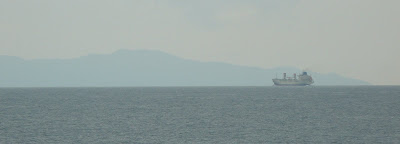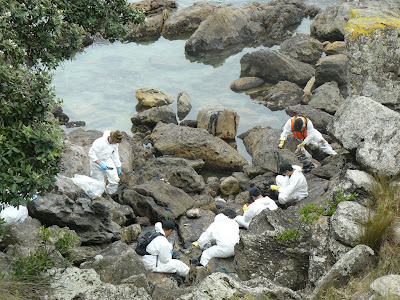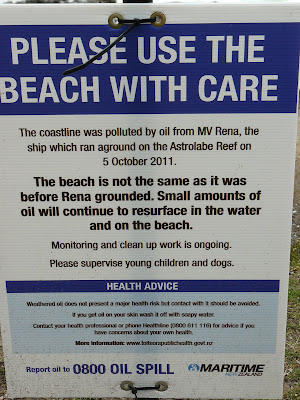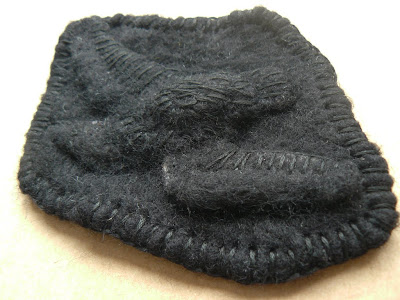
I visited the
Tauranga oil spill today. Mount
Maunganui beach was reopened this weekend and declared safe for swimming (with the caveat that you should get out of the water if you suspected oil contamination). So I wasn't sure if I'd actually get to see any oil, since all the other beaches in the Bay of Plenty are closed to the public.

There seemed to be lots of people on the beach: a salsa dancing demonstration was drawing a crowd,
paragliders drifted down from the top of the mountain and plenty of folk were noodling around on the sand. I didn't see anyone in the water, but that may have been as much to do with the cool drizzly weather as fear of oil.

The woman at the information centre told me that I might be able to glimpse the stranded container ship, Rena, if I walked around the headland track and the sky were clear. There was too much haze to see anything but one of the naval vessels
patrolling the exclusion zone, and the helicopters taking salvage crews to and from the Rena. But there were dozens of people walking along the track.

For the first section of my walk, I was going against a tide of local volunteers returning from their clean up clutching
haz-bagged gumboots and talking animatedly as strangers do when a disaster unites them as neighbours. Tractors towed trailers loaded with sacks of oil, oily sand, oily shells and oily protective clothing.

I found just one little track that was not blocked with emergency tape. Taking advantage of a rare break in the crowd, I sneaked down to the water's edge to try and find some oil I could inspect up close. I've been thinking so much about how I want to represent this oil spill in stitching. My oil spill images last year were mostly inspired by photos from the Gulf of Mexico, but the oil in
Tauranga is of such a different quality, I can't use that oil spill to represent this one. I didn't touch any of the oil I found, and I was careful not to get it on my shoes and track it around the Mount.

Rena's spill may be small compared to international spills. It's certainly tiny compared to what is possible if deep sea drilling were to happen off shore of New Zealand. But the fuel used in container ships is the nasty dregs of the oil distillation process, literally the crudest of crude oils. It looks exactly like tar, and nothing at all like petroleum or even machine oil.

The beaches are relatively easy to clean up, because the oil-saturated sand can be shovelled up. Clumps of oily shells and debris are picked out. The nasty gunk is hauled off out of sight to landfill and not even a stain remains.

It's fiddly work, cleaning oil out of sand, but the cleaner-uppers have done an amazing job. News photos from a week ago showed Mt
Maunganui beach covered in thick black sludge and now there's no trace of oil to be seen on the apparently pristine white sands.

But off the sandy beach and around the headland is a different story. The oil still clings to rough rocks around the high tide mark.

Here the army cleanup crew has to scrape and scrub, which looks to be very slow and laborious. They are working very carefully, paying minute attention to each crevasse or stain on the rocks. Their work reminded me a little of my own slow, absorbing stitching practice.

Despite the hard work of removing toxic gunk, the crew I observed seemed in very good spirits. I think it must be extremely satisfying to be doing something so valuable, so tangible and so effective. After ten days, most of the volatiles have evaporated from the oil, and it no longer smells bad. In fact, the Port of
Tauranga had a worse oil stench when I drove past it.

A couple of New Zealand fur seals lounged on some rocks just off the headland. Signs on the track assured us that they'd been checked and are free of oil. I saw a dozen or so seagulls, swallows and a
tui on my walk, and heard a grey warbler, all in fine spirits. But I thought of all the sea birds that have been killed by the oil in the last couple of weeks, and those that have been saved but must be kept in captivity until their homes are cleaned up and out of further risk. And I thought of all the fish and other sea creatures that have already been poisoned, and those that will continue to absorb the toxic residues for years to come. And those very fish are what the seals eat. So I'm not confident at all that a nice clean beach means everything is fine now.

The salvo crew is working night and day to try and pump out the remaining oil on the Rena before it breaks up. They are apparently managing to move about 10 sluggish tons an hour, in conditions of extraordinary danger and difficulty. The huge cracks in the hull, the ship's alarming tilt, and the bizarrely disarrayed containers all suggest that it would only take a bad storm or a small tsunami (there was a brief tsunami warning yesterday which thankfully came to nothing) to send the remaining 1000 or so tons into the sea. We are all praying that doesn't happen, because if it does, the thick black sludge that has been mostly cleaned up since last week will seem like a drop in the ocean.











































